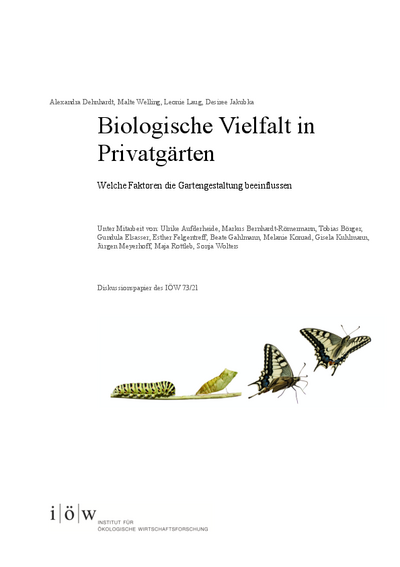Biological Diversity in Home Gardens Which Factors Influence Garden Design
Private gardens in Germany have a great potential for protecting biodiversity. However, this potential is increasingly limited, as biodiversity is also deteriorating in private gardens as a result of steadily decreasing structural diversity, the choice of 'wrong' plants or the increasing sealing of areas. Biodiversity protection policies are therefore focusing more on the design of private gardens.
The aim and focus of the first phase of the gARTENreich project, the results of which are presented in this discussion paper, was therefore firstly a detailed analysis of the problem situation, the need for action as well as the state of knowledge and the need for knowledge from both a natural science and a social science perspective. Secondly, an initial analysis was carried out to determine, which factors (determinants) inhibit or support a biodiversity-friendly design of private gardens. Furthermore, first municipal starting points were identified on how to promote biodiversity-friendly garden design. In addition to an extensive literature review, qualitative, guided interviews and two workshops with garden owners from Gütersloh were conducted for this purpose.
Private gardens can contribute to biodiversity, but they are very heterogeneous in terms of size and structural diversity and consequently their species richness. Factors such as garden size influence plant diversity, the presence of different habitats and the species richness of woody plants in turn have positive effects on the diversity of birds, insects and reptiles.
Regarding the importance of socioeconomic determinants, literature analysis and interviews showed that knowledge about the importance of biodiversity and different design options in one's own garden is a major influencing factor. Other influencing factors include maintenance effort, aesthetic preferences, and neighborhood or societal norms.
Building on the results of the first phase, the second phase of the project gARTENreich will use an inter- and transdisciplinary research design in a three-year collaborative project (2021-2024) to determine how home gardens can contribute to the protection and promotion of biodiversity at different spatial levels. At the local level and nationwide, the determinants influencing garden design will be analyzed and the research team will develop strategies as well as communication and implementation approaches including funding instruments for more biodiversity in home gardens.



